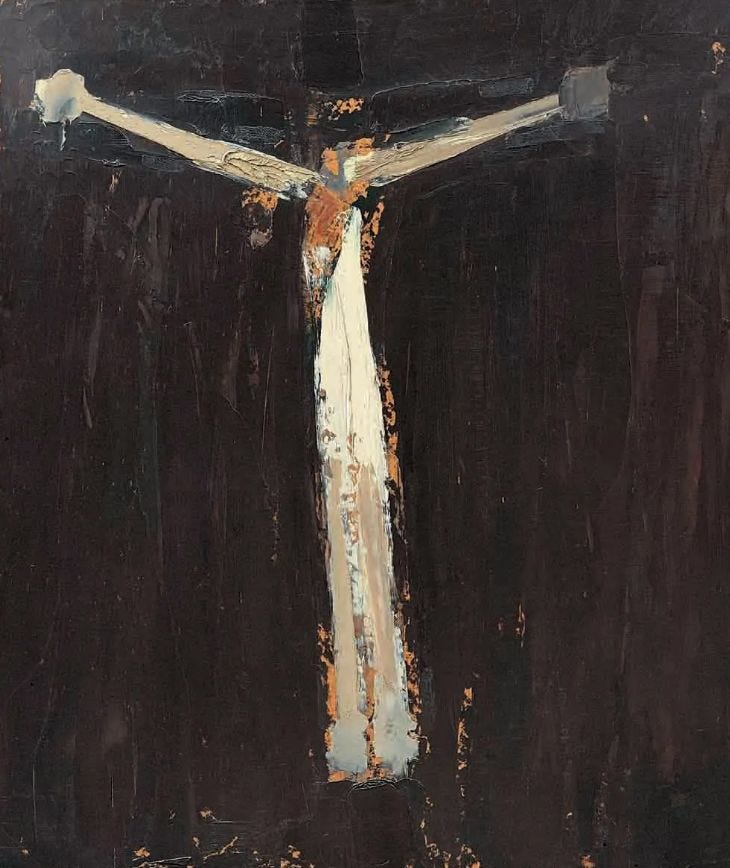The Devil is Too Laughable to be Taken Seriously
Christ's passion puts the powers on display in open shame
From a wealthy New England family, William Congdon volunteered as an ambulance driver during World War II. He was the first American to enter the death camp at Bergen Belsen, images from which left an indelible impression on him. Inspired by the artwork he saw during his service in Europe, Congdon took up painting after the war and became one of the century’s most notable exemplars of abstract expressionism. In 1959, after a visit to Assisi, Congdon converted to Christianity and thereafter painted bleak iterations of the crucifixion as though both the cross and the concentration camp haunted him.
His most famous painting, 1960’s Crucifixion No. 2, renders Jesus as the only object to view. In it, there are no soldiers mocking Jesus nor any thieves deriding him or asking his mercy. There is no purple robe or chief priests. There is no crown of thorns or weeping mother. There is no crowd jeering him to come down from his cross; for that matter, there is no cross. His body itself is the cross, stretched out in the shape of T on a sheer black backdrop. As though nailed to nothingness, he is the solitary spectacle we are meant to behold.
Congdon’s artwork is certainly arresting and surely truthful in its bleak refusal of any beauty to be found behind Christ’s passion; however, the Gospel narratives themselves do not put Christ on display as much as everyone else who contribute to handing Christ his cross to carry to Calvary.
Pontius Pilate sends a man, whom he knows to be innocent, to a brutal and dehumanizing death. “Crucify him yourselves,” Pilate tells the chief priests, "I find no guilt in him.” Nevertheless, without a second thought, Pilate condemns Jesus to a manner of execution so ghastly the word crux was verboten on the lips of polite Roman citizens.
Pilate not Jesus is the one the scriptures put on display.
Not only is Jesus not guilty, he alone is the righteous one.
But those who know of righteousness, the chief priests, they plead for his crucifixion. Under the law, the priests already possess the authority to put him to death. In fact, they’ve attempted to stone Jesus twice. It’s not that they lack the authority to put Jesus to death. It’s that they want Jesus to die a death only Rome can execute. It’s no longer enough for them to stone Jesus. They want Jesus to be crucified. According to the Book of Deuteronomy, “anyone hung on a tree is under God’s curse.” Thus, they want Jesus crucified because crucifixion will invalidate Jesus. They want more than the death of Christ. They want to nail Jesus’s Kingdom message into blessed oblivion.
They are the spectacle the scriptures want you to see.
When Pilate sarcastically arraigns the would-be king of this kingdom before the chief priests (“Behold, your King!”), the chief priests, those chosen from the tribe of Levi to intercede on behalf of the covenant people so that Israel would be a light to the nations, having no other god but Yahweh, exclaim, “We have no other king but Caesar.”
If Israel’s original failure in the Old Testament is the desire to have a king like the other nations, then Israel’s original sin happens here, not in the Garden but on Good Friday, when they choose the king named Caesar over the true God.
Jesus is not the one on display.
Perhaps this is why he is so poised before Pilate. In verse eleven, Jesus minimizes Pilate’s authority by suggesting the Father’s authority alone has brought Jesus before this judge.
Just as the Holy Spirit thrust Jesus before the tempter in the desert immediately following his baptism, the Father has handed him over to Pilate and the priests and brought him to the place the Gospel of John calls Gabbatha, the judgment seat.
For what purpose?
The Epistle to the Colossians claims that Christ in his passion unmasks the rulers and authorities and puts them on display in open shame.
Another question:
What is underneath the masks Jesus removes from those rulers?
A better question:
Who is the person behind their guises which Jesus unveils?
Precisely because the devil is a person without a self, an agency without substance, a being without a body— invisible, we require help to identify him.
In other words, to unmask Satan’s temptations Christ must be tempted by them.
Keep reading with a 7-day free trial
Subscribe to Tamed Cynic to keep reading this post and get 7 days of free access to the full post archives.


